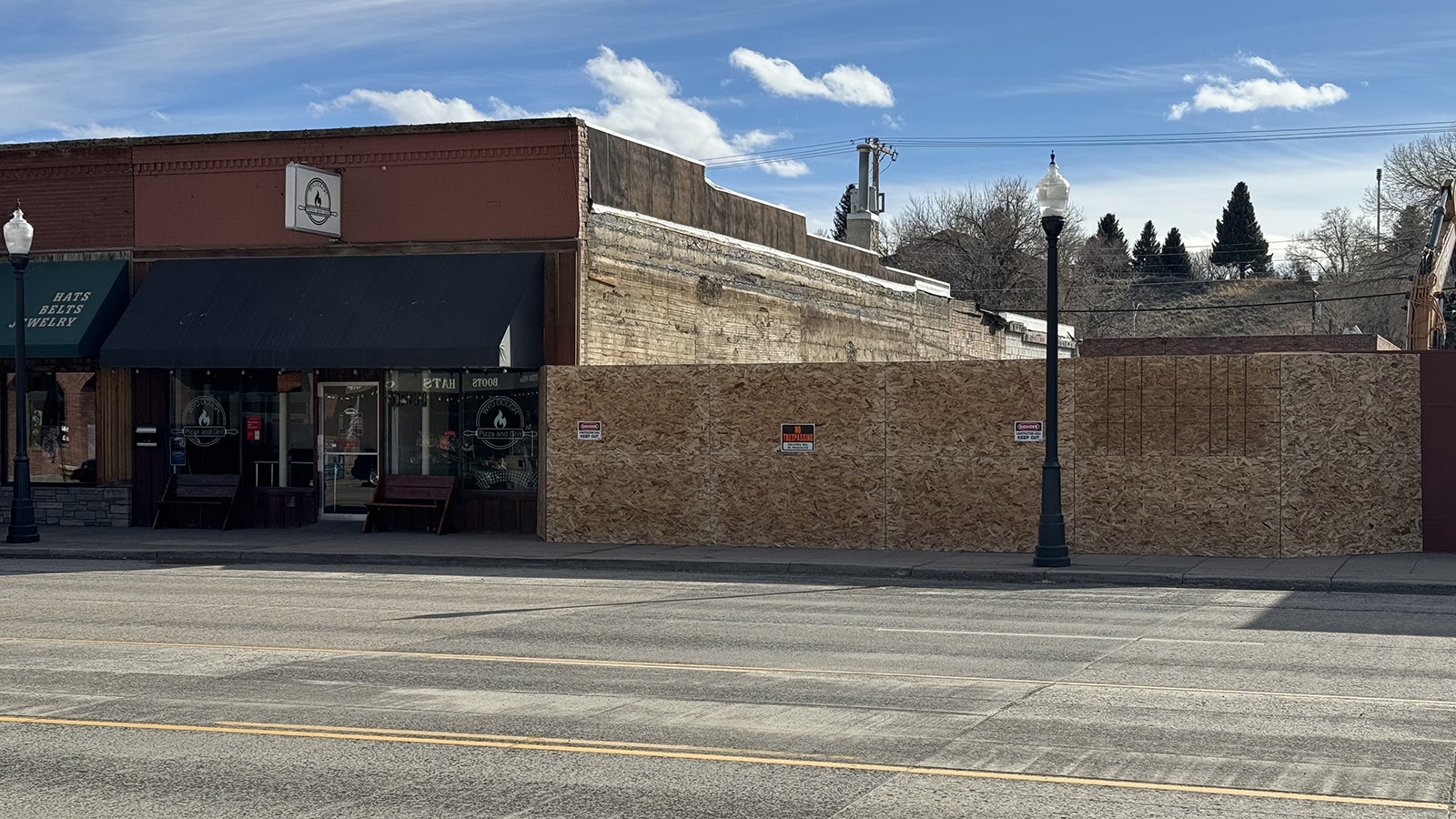Cody is a town that loves its Western and Wyoming legacy, but it is about to lose two more of its 100-plus-year-old buildings within its historic district.
Work has already begun to demolish both the Shuler Market & Grocery at 1236 Sheridan Ave., which was built in 1918, and the Cafe at 1244 Sheridan Ave., built in 1920. They’re adjacent lots.
The buildings have had many uses over the decades in Cody. Their demolition came to the attention Robyn Cutter with Park County Archives after the building at 1234 Sheridan Ave., a newer structure that used to house Eagle Real Estate, was torn down.
Its demolition revealed a couple of Western murals on the exposed concrete walls. Cutter was asked for information about the murals, which prompted her to look more closely in general at that block of the town’s historic district.
What she has learned has her concerned for the future of historic preservation in her town, as there are no rules that require anyone to notify the public that a historic structure is coming down, Cutter said.
That fact has already contributed to the demolition a year ago of a home owned by Caroline Lockhart, famous in the early 1900s for writing novels such as “The Fighting Shepherdess” and “The Man From the Bitter Roots,” and the one-time founder of the famous Cody Stampede.
“Someone from out of own came in and bought it and tore it down,” Cutter said. “They probably only needed a demolition permit.”
Cutter was among those taking photos as the Lockhart home was demolished.
“I had two people say, ‘I wish I’d have known, I could have moved that up the street here and preserved it,’” Cutter said.
Within a short period of time, Lockhart was also told by a couple of people that losing the Lockhart home made them “sick.”
“To this day, people are coming to me and saying, ‘I’m sad that the history that pertains to that house is gone,’” Cutter said.
Now, with two more century buildings seemingly suddenly coming down in Cody’s historic district, Cutter is wondering if the city’s current system is adequate for historic preservation. She’s also wondering what will take the place of the old buildings, and whether the new structures will preserve the historical look and feel of the downtown’s historic district.
“Obviously, our streetscape, like many towns, you know, there’s bits and pieces that have been remodeled over the years and some people have preserved and some have not,” she said. “But it’s sad to see 100-plus-year-old structures being demolished.
“Maybe we’ve got to develop a system, you know, after a structure is more than 75 years old that it should be reviewed and discussed.”

Restrictions Aren’t Strict
Cody’s historic district encompasses both sides of Sheridan Avenue from 1313 to 1155 on the north side and from 1286 to 1192 on the south side of the street, according to the application form for the district’s listing on the National Register of Historic Places.
According to the form, the designation is based on the district containing many historically significant buildings dating from the 1900s to 1930s, most of which have retained their architectural integrity.
“The Cody buildings are typical of other commercial structures built in Wyoming during the same period,” the application states. “Yet the sandstone buildings constructed of locally quarried materials lend the district a distinctive Western character. The sandstone and brick detailing of the facades represent a simple, stylistic approach to commercial design.”
The application lists 20 buildings that contribute to the historical designation and 10 that do not. Chief among the contributing buildings listed on the form is the Irma Hotel at 1192 Sheridan Ave., which was separately listed in the National Register of Historic Places in 1973.
The application goes on to state that the association of Buffalo Bill Cody with the downtown gives the district a solid and important place in the history of Wyoming and America in general, making it very deserving of its place on the National Register.
Of the two structures that are coming down, the building at 1236 is considered noncontributing, while the Café at 1244 Sheridan Ave. is contributing, according to the application.
One common misconception about listings on the National Register of Historic places is that the designation comes with a lot of legal restrictions. A building or a district that changes too much could lose its place on the list, but that’s really the only consequence.
Cody, meanwhile, doesn’t have particular rules that pertain to demolishing a historic structure. Property owners must get a permit to demolish a structure, historic or not, and do the work in a safe manner.
Property Rights And Historic Preservation
Cody Mayor Matt Hall told Cowboy State Daily the demolition of the Lockhart property was something that happened quickly, before anyone was aware of it happening.
He also said he agrees that concerns about retaining the historic character of Cody’s Main Street are legitimate, but that the city also has to balance such concerns with existing ordinances and the rights of property owners.
“Property rights are part of the equation that you have to deal with,” he said. “And we’re just hoping developers who want to do something with their property bear in mind some of the cultural aspects of the town.”
But the city is limited in how strictly it can enforce that wish.
New structures taking the place of the old buildings that are being demolished will have to go through the usual planning and zoning process, City Planner Todd Stowell told Cowboy State Daily, but any requirements governing what the new structures will look like are fairly general in nature.
“We like to see them utilize the materials that are seen elsewhere on Main Street,” Stowell said. “You know, for example, the brick, the other architectural enhancements. But we’re fairly flexible. It’s not required to meet a specific architectural style, for example, not even specifically Western, Old West style or anything. It just that it needs to have that general compatibility, as determined by the Planning and Zoning Board in their role as our control review.”
Stowell said the city so far has not received a plan for any of the locations on Sheridan Avenue that are being demolished.
Frank Givens, an independent contractor for the Collier Group, which owns the buildings, told Cowboy State Daily no plans have been finalized for the location yet.
“I’d say we’re probably 30 to 45 days away from having a plan,” Givens said. “We haven’t presented anything to the city because we don’t have anything to present.
“I’d like to be more helpful, because I’d like for the city to be excited about it,” he added.
Some Counties Have Demolition Notices For Historic Buildings
Park County Archives Curator Brian Beauvais echoed Cutters’ concerns about the sudden loss of historic structures, although he stressed that as a county entity, they really have no role in the city’s historic downtown, other than to serve as a resource if someone has questions about historic preservation.
However, he does wish there could be more of a public discussion around the demolition of historic buildings in general.
Those discussions might include coming up with a plan to salvage some of the historic materials and put them on display elsewhere or, in the case of the Lockhart home, perhaps a discussion could have been had about moving the structure elsewhere to preserve it.
“But at the same time, on the Park County Preservation Commission, we don’t want to tell people, we can’t really tell people what to do with their private property,” Beauvais added. “I think change is inevitable, and we have to be able to deal with that. We have to sort of do that wisely. But we can’t say that it can’t happen at all.”
Historic preservation efforts, meanwhile, are very expensive. Because of that, Beauvais said they must be carefully targeted to buildings that are really worth saving.
“I mean, if we said we had to preserve those buildings, we would have to say that for every single building in Cody,” he said. “And unfortunately, that’s just not realistic. We kind of have to pick our battles on these historic preservation projects. We can’t die on every small hill when something is torn down. That’s just how the world works, unfortunately.”
One thing that Beauvais has done is look at an ordinance in Teton County that requires notice whenever a historic building there is going to be demolished.
“We’ve actually briefly discussed this in, like, not as it deals with like city limits, but historic buildings like on the National Register within Park County,” Beauvais said.
There hasn’t been a lot of support for the idea as yet, he added.
“I haven’t heard any calls from the public or local leaders for such measures,” Beauvais said. “Maybe these most recent demolitions will spark something?”

Renée Jean can be reached at renee@cowboystatedaily.com.













